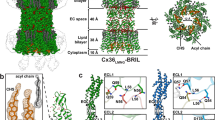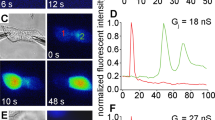Abstract
GAP junction channels are structurally distinct from other ion channels in that they comprise two hemichannels which interact head-to-head to form an aqueous channel between cells. Intercellular voltage differences together with increased intracellular concentrations of H+ and Ca2+ cause closure of these normally patent channels1. The relative sensitivity to voltage varies with the subunit (connexin) composition of the channels2. The third of four transmembrane-spanning regions (M3) in connexins has been proposed to form the channel lining3, and a global 'tilting' of the hemichannel subunits has been correlated with channel closure4. But specific components involved in transduction of channel gating events have not been identified in either gap junctions or other ion channel classes (however, see model in ref. 5). We have examined a strictly conserved proline centrally located in M2 of connexin proteins. Mutation of this proline (Pro 87) in connexin 26 causes a reversal in the voltage-gating response when the mutant hemichannel is paired with wild-type connexin 26 in the Xenopus oocyte system. This suggests that the unique properties associated with this residue are critical to the transduction of voltage gating in these channels.
This is a preview of subscription content, access via your institution
Access options
Subscribe to this journal
Receive 51 print issues and online access
$199.00 per year
only $3.90 per issue
Buy this article
- Purchase on Springer Link
- Instant access to full article PDF
Prices may be subject to local taxes which are calculated during checkout
Similar content being viewed by others
References
Spray, D. C. & Bennett, M. V. A. Rev. Physiol. 47, 281–303 (1985).
Hennemann, H. et al. J. Cell Biol. 117, 1299–1310 (1992).
Milks, L. C. et al. EMBO J. 7, 2967–2975 (1988).
Unwin, P. N. T. & Ennis, P. D. Nature 307, 609–613 (1984).
Guy, R. H. & Conti, F. Trends Neurosci. 13, 201–206 (1990).
Yun, R. H., Anderson, A. & Hermans, J. Proteins Struct. Funct. Genet. 10, 219–228 (1991).
Barlow, D. J. & Thornton, J. M. J. molec. Biol. 201, 601–619 (1988).
Deisenhofer, J. et al. Nature 318, 618–624 (1985).
Henderson, R. et al. J. molec Biol. 213, 899–929 (1985).
Schulz, G. & Schirmer, R. H. Principles of Protein Structure (Springer, New York, 1979).
Brandl, C. J. & Deber, C. M. Proc. natn. Acad. Sci. U.S.A. 83, 917–921, (1986).
Lolkema, J. S., Puttner, I. B. & Kaback, H. R. Biochemistry 27, 8307–8310 (1988).
Mogi, T., Stern, L. J., Chao, B. H. & Khorana, H. G. J. biol. Chem. 264, 14192–14196 (1989).
Fimmel, A. L. et al. Biochem. J. 213, 451–458 (1983).
Barrio, L. C. et al. Proc. natn. Acad. Sci. U.S.A. 88, 8410–8414 (1991).
Bennett, M. V. L. et al. Gap Junctions (eds Hertzberg, E. L. & Johnson, R. G.) 287–304 (Liss, New York, 1988).
Werner, R. et al. Proc. natn. Acad. Sci. U.S.A. 86, 5380–5384 (1989).
Verselis, V. K. et al. Neurosci. Abstr. 22nd annual meeting, Anaheim CA, Oct. 25–30, Abstr. 275.10 (1992).
Veenstra, R. D. Am. J. Physiol. 258, C662–C672 (1990).
Reed, K. E. et al. J. clin. Invest. 91, 997–1004 (1993).
Haefligers, J. A. et al. J. biol. Chem. 267, 2057–2064 (1992).
Connolly, L. G. Comp. Biochem. Physiol. 93A, 221–231 (1989).
Grenningloh, G. et al. Nature 338, 215–220 (1987).
Schofield, P. R. et al. Nature 328, 221–227 (1987).
Willecke, K. et al. J. Cell Biol. 114, 1049–1057 (1991).
Kunkel, T. A. Proc. natn. Acad. Sci. U.S.A. 82, 488–492 (1985).
Author information
Authors and Affiliations
Rights and permissions
About this article
Cite this article
Suchyna, T., Xu, L., Gao, F. et al. Identification of a proline residue as a transduction element involved in voltage gating of gap junctions. Nature 365, 847–849 (1993). https://doi.org/10.1038/365847a0
Received:
Accepted:
Issue Date:
DOI: https://doi.org/10.1038/365847a0
This article is cited by
-
Structure of the gap junction channel and its implications for its biological functions
Cellular and Molecular Life Sciences (2011)
-
Structure of the connexin 26 gap junction channel at 3.5 Å resolution
Nature (2009)
-
Mutations in the human connexin gene GJB3 cause erythrokeratodermia variabilis
Nature Genetics (1998)
Comments
By submitting a comment you agree to abide by our Terms and Community Guidelines. If you find something abusive or that does not comply with our terms or guidelines please flag it as inappropriate.



